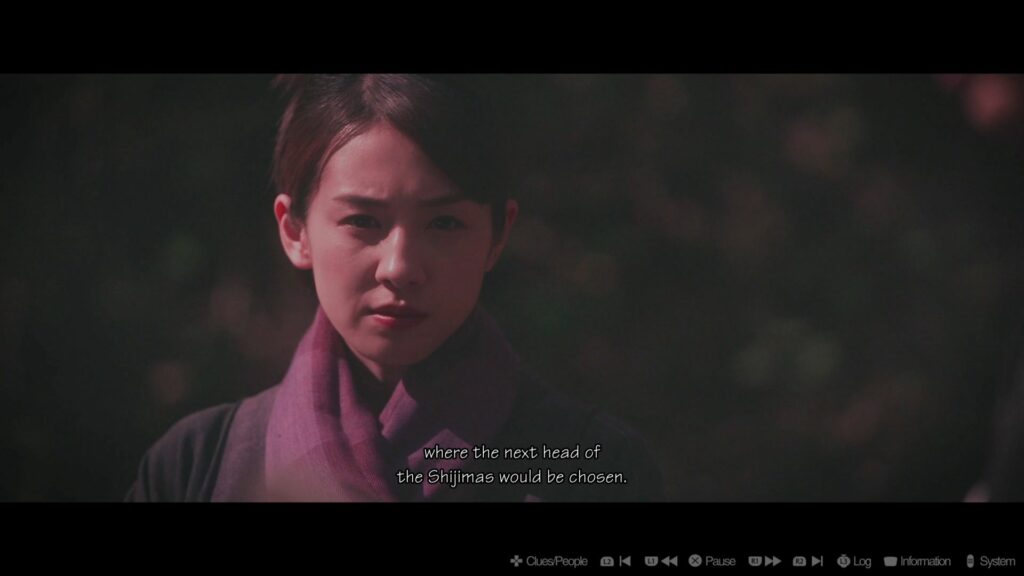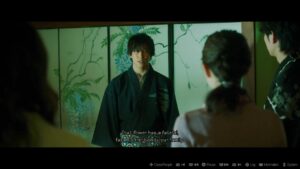The Centennial Case: A Shijima Story has been available for a week now, and even Hideo Kojima has played it. Maybe also because Koichiro Ito, a former member of his staff, worked on the game in a leading role.
Koichiro Ito, who was the director of The Centennial Case, Junichi Ehara (Producer), and Yasuhito Tachibana (Cinematographer) were available to answer some questions about the game. Have fun reading!
Live action video games are not a particularly common genre. What is the appeal for you as a developer to create a video game with real movie scenes? What opportunities do live action scenes offer in games that classic games don’t?
Mr Ito: Photorealistic CG has made great advancements in recent years, ever more closely approaching live action graphics. Even so, it requires a lot of effort and cost to depict subtle movements of the eye, expressions, the breath and warmth of characters. Live action feels like an effective and compelling medium for expressing those subtle, human elements. By having real-life actors performing in The Centennial Case: A Shijima Story, I think we’ve been able to depict a theme of the plot – life and death – in a way that feels more real.
Mr Tachibana: We thought that it would make it possible to convey emotions with a great sense of reality and more subtlety than with CG. Without impeding the way in which the characters’ expressions act as a vital source of information in a mystery game, we were able to add another layer of complication that can’t be easily converted into pure information. I hope that this draws players even deeper into the story, and they find the game all the more satisfying as a result.
I think there are some reservations about live action games. Players might think they’re just watching a „movie“ and have little impact on the medium. That’s obviously not the case with The Centennial Case. If you make the wrong decisions, the player can expect a „bad ending,“ according to the announcement trailer. What are the consequences and influence of player decisions?
Mr Ehara: The important thing is whether the player’s reasoning is correct, rather than the decisions they make. We’ve set the required deduction at the appropriate difficulty level to make the process of figuring out the killer fun – but the game includes hint features, so you won’t need to use any online walkthroughs.
Mr Ito: The Centennial Case: A Shijima Story isn’t a game with multiple stories and endings, it’s a game where you have to work your way through different choices to arrive at the one and only truth. If you make the wrong choice, the suspects will retort and point out your error (which might turn out to be a slight hint for you), after which you can get back to your reasoning right away.
FMV games may seem like the player spends a lot of time just watching videos, but in The Centennial Case: A Shijima Story, as far as possible, we’ve tried to design the game in a way that means you’ll be using your brain even when you’re not controlling the game. By stepping away from the controls and closely observing the video, you might notice some truths that you’d previously missed.
With video games that have two or more such standout features, I often wonder which idea was the first. The Centennial Case puts the story first and has chosen an unusual presentation. Did the story come first, and then you chose the presentation? Or did you want to make a live action game, and then the story emerged?
Mr Ehara: We decided the genre first, then Mr Ito thought up the structure of the game, creating the plot after that.
Mr Ito: We met Mr Yasuhito Tachibana, the Cinematographer and Scenario Director, and first of all decided to create a game using live action, which he excels at creating. The reason we chose the mystery genre is because Mr Ehara and I are great mystery fans. Neither live action nor the mystery genre will appeal to everyone, but we intentionally decided to take on this combination to use our areas of expertise to their full potential. We created the story and game mechanics after robust discussions on the drawbacks of both the style of presentation and genre.
Back to the gameplay elements of the game. The Centennial Case reduces them to three important phases: Incident Phase, Reasoning Phase, and Solution Phase. Can you give us some insights into how these phases are related and when they occur?
Mr Ehara: The Incident Phase is the part where you obtain clues. The Reasoning Phase is where you use those clues to create hypotheses. And the Solution Phase is the part where you find the killer, based on your hypotheses.
Mr Ito: In The Centennial Case: A Shjima Story, the roles are clearly divided between the three parts. The flow consists of establishing a state where all the information necessary to determine the truth has been revealed (the Incident Phase), then the player performs their deductions (the Reasoning Phase), and then they solve the murder case (the Solution Phase).
One thing we paid particular care to was making sure that all the elements required to expose the trick the killer used to carry out the crime were fully shown in the video footage of the Incident Phase. And so, I think it might be fun to take a moment after having seen the Incident Phase in its entirety to play the part of a great detective yourself, and imagine what the truth might be in your own mind.
The Incident Phase differs according to chapter, but it’s the section that covers the happenings up to the point where a murder has taken place and you have heard testimony from the suspects. Once you’ve created a certain number of hypotheses in the Reasoning Phase, you’ll be able to move onto the Solution Phase whenever you like. However, you’ll need to be careful – you might not have all the hypotheses you need to expose the truth. In the Solution Phase, you’ll reveal the killer and the trick they used for the murder with the hypotheses you’ve created and several dialogue options.
Koichiro Ito, you worked on 428: Shibuya Scramble as a writer as well, I’ve read. What experience do you bring back from that project?
Mr Ito: The genre of 428 was a multi-protagonist suspense game, and I wrote these multiple protagonists to all be somewhat endearing. However, The Centennial Case is a mystery, with all of the characters made to appear suspicious. This was a major difference in the creative work. For the fast-paced end section of the game that carefully picks up on lots of foreshadowed elements, and for the twists in the story, I used the knowledge I developed during the creation of 428 and polished it even further.
Yasuhito Tachibana, you were a producer on the Netflix original „The Naked Director“. Is this your first time working on a video game? What challenges do you encounter when working with video games? Or is the work not so different from that with series and films?
Mr Tachibana: Yes, this is the first time I’ve worked on a game. Broadly speaking, I didn’t find it too different to working on TV dramas or films. However, if I were to give an example of one significant difference, I found I had to expand my imagination even more than usual, to encompass the player experience and emotions, which will not always follow the same path.
With a drama or film, you can restrict the presentation and emotional world to a single viewpoint, but with a game, you need to be aware of not pushing that too strongly and allowing the player to enjoy multiple possibilities. That was a challenge, but I also think it made it even more enjoyable than usual to work together with the actors and staff to create the piece.
Different paths, consequences and possibilities, it sounds like you could play The Centennial Case multiple times. Such games are often characterized by multiple endings, both good and bad. How long does it take players to complete a common playthrough, and are there different ending sequences?
Mr Ehara: No, you can essentially think of it as a linear story. However, in exchange, we’ve created a high-quality narrative and reasoning experience. If your deductions are incorrect, the story will branch into a bad ending – but these are more like skits.
If you want to make your game palatable to someone who is unsure if the genre is for them, how would you want to convince them and make them curious?
Mr Ehara: I think that some past FMV games have felt lacking in the gameplay department. However, The Centennial Case: A Shijima Story leans more heavily into this aspect, and we took pains to ensure that it really felt like a game. I believe that the enjoyment of solving puzzles and the surprise of learning the secret behind mysteries that have been set up is something that can appeal to everyone. The whole team worked together to create the gameplay and story that would expand on those elements to their fullest.
The Centennial Case: A Shijima Story. I can imagine some analogy here. The Next Case: A Different Story. Could it be that protagonist Haruka Kagami will solve other mysterious cases in the future?
Mr Ehara: If The Centennial Case: A Shijma Story performs well, I would love to make a sequel. We already have ideas for one!
Mr Ito: I hadn’t thought about it like that, haha. In the game, a character called Makoto Nishimari appears – a great detective from the series of novels written by Haruka Kagami. It might be interesting to create a sequel or a spin-off about his adventures.
Bildmaterial: The Centennial Case: A Shijima Story, Square Enix, h.a.n.d.









0 Kommentare